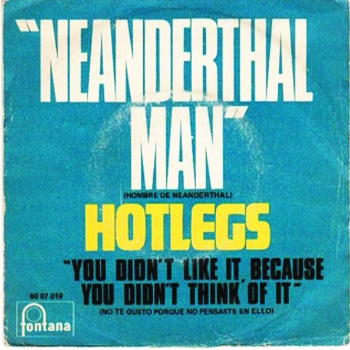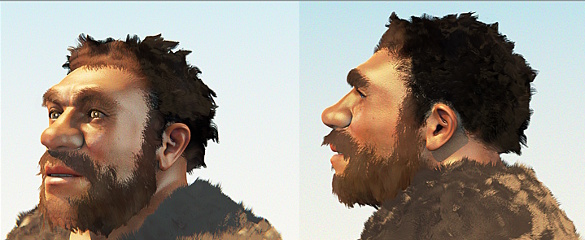Curse of the Neanderthal DNA
March 7, 2016
Neanderthal Man was a
record by the
English band,
Hotlegs. It was released on June 19, 1970, at about the time of my exit from
commercial radio broadcasting. Neanderthal Man was a reduction of
rock-and-roll music into its basic elements, so it was like the musical
analog of the
abstract art movement.[1] It had a
repetitive drum beat, and a nearly inaudible
lyric reminiscent of another song,
Louie Louie. The record was popular, selling two million copies.
It's easy to see how this record was named. The overarching drum beat evokes the image of
primitive men dancing around a
campfire; or, at least, our popular conception of what primitive men would do around a campfire. The
human subspecies,
Homo sapiens neanderthalensis, the Neanderthal Man, which became extinct around 40,000 years ago, was not that different from
modern man.
DNA analysis has shown that Neanderthal and human genomes are at least 99.5% identical.[2]
In our present age,
women swoon over
athletic males, so it's understandable that there would have been
cross-breeding between
Homo sapiens and the Neanderthal. These
subspecies derive from a
common ancestor who lived about half a million years ago, with the Neanderthal living in
Europe and
Asia and Homo sapiens staying in
Africa.[3] Such cross-breeding occurred when Homo Sapiens started to leave Africa about 100,000 years ago.[3]
Neanderthal contributions to our present genome aren't concentrated. Different people have different Neanderthal
genes, some of which aid against
infection.[3] One problem is that, unlike
fruit flies, which still cross-breed well after being separated by many thousands of
generations, sapiens and neanderthalensis were somewhat incompatible after just a few tens of thousands of generations.[3] This evokes the possibility that some Neanderthal genes were harmful in cross-breeds, and such genes were not passed along to modern man.[3]
However, some problematic genes have passed along to the present day, and these are the subject of a recent study by a large international team of
scientists.[4-7] Their
analysis is published in a recent issue of
Science.[4] Members of the
research team are associated with
Vanderbilt University (Nashville, Tennessee), the
University of Washington (Seattle, Washington), the
Mount Sinai School of Medicine (New York, New York), the
University of Washington Medical Center (Seattle, Washington),
Northwestern University (Chicago, Illinois), the
Marshfield Clinic (Marshfield, Wisconsin), the
Mayo Clinic (Rochester, Minnesota), the
National Institutes of Health (Bethesda, Maryland),
The Pennsylvania State University (University Park, Pennsylvania), the
Geisinger Health System (Danville, Pennsylvania),
Stellenbosch University (Tygerberg, South Africa), and
Case Western Reserve University (Cleveland, Ohio).[4]
Different people have different snippets of Neanderthal DNA in their genome. By sampling many modern people, about 20% of the Neanderthal genome can be found, so today's humans on every
continent are reservoirs of a varied mixture of
archaic and modern DNA.[8-9] Says
Svante Pääbo, a
paleogeneticist at the
Max Planck Institute for Evolutionary Anthropology in
Leipzig, Germany, who did early work on this topic, "The Neanderthal genetic contribution to present-day people seems to have larger
physiological effects than I would have naively thought."[5] Interestingly, such archaic DNA is absent from most Africans, since the cross-breeding happened outside Africa.[5]
Tracking how Neanderthal DNA affects modern humans was only possible through use of a
medical database called the
Electronic Medical Records and Genomics (eMERGE) Network which contains a patient's genetic data and medical data. This allowed
correlations to be made between genes and
symptoms for 28,416
American adults
of
European ancestry.[4-6]
What was found is a correlation to such conditions as
actinic keratosis (
skin lesions from exposure to
ultraviolet light),
hypercoagulation,
tobacco use, and the risk of
depression.[4] Hypercoagulation would have been beneficial to Neanderthals, who lived in a dangerous
environment, since a rapid
healing of
wounds would prevent
pathogens/a> from entering the body.[5-6] For modern man, however, it results in an increased risk of blood clots and
strokes. Blood clots and strokes were not a problem for the Neanderthals, who died young.[5]
Some Neanderthal genes were found to be linked with depression and
nicotine addiction.[5-6] Quite a few snippets of Neanderthal DNA were correlated with
psychiatric and
neurological effects.[6] Other Neanderthal genes relate to an ineffective use of
thiamine (vitamin B1), which
metabolizes carbohydrates
in the
intestine. Having such Neanderthal genes might predispose people to
malnutrition.[5] Correlates to
incontinence,
bladder pain, and
urinary tract disorders were also found.[5]
 | Show me where it hurts.
Human maladies associated with Neanderthal DNA.
(Base image from J. Casserius, Tabulae anatomicae LXXIXX, photo number L0022375, from the Wellcome Trust, via Wikimedia Commons.) |
Lest you think that all our genetic inheritance from the Neanderthal is all bad, two studies recently published in the
American Journal of Human Genetics have found three archaic genes that boost immune response.[5] However, even these immune system boosters have a downside of increased
allergies.[5]
References:
- Neanderthal Man by Hotlegs, YouTube video, June 17, 2010. The artists are incorrectly given as 10cc, the name of their subsequent band.
- James P. Noonan, Graham Coop, Sridhar Kudaravalli, Doug Smith, Johannes Krause, Joe Alessi, Feng Chen, Darren Platt, Svante Pääbo, Jonathan K. Pritchard, and Edward M. Rubin, "Sequencing and Analysis of Neanderthal Genomic DNA," Science, vol. 314, no. 5802 (November 17, 2006), pp. 1113-1118, DOI: 10.1126/science.1131412.
- Ewen Callaway, "Modern human genomes reveal our inner Neanderthal," Nature News,January 29, 2014.
- Corinne N. Simonti, Benjamin Vernot, Lisa Bastarache, Erwin Bottinger, David S. Carrell, Rex L. Chisholm, David R. Crosslin, Scott J. Hebbring, Gail P. Jarvik, Iftikhar J. Kullo, Rongling Li, Jyotishman Pathak, Marylyn D. Ritchie, Dan M. Roden, Shefali S. Verma, Gerard Tromp, Jeffrey D. Prato, William S. Bush, Joshua M. Akey, Joshua C. Denny, and John A. Capra, "The phenotypic legacy of admixture between modern humans and Neandertals," Science, vol. 351, no. 6274 (February 12, 2016), pp. 737-741, DOI: 10.1126/science.aad2149. This is an open access paper with a PDF file available here.
- Ann Gibbons, "Our hidden Neandertal DNA may increase risk of allergies, depression," Science, February 11, 2016.
- David Salisbury, "Neanderthal DNA has subtle but significant impact on human traits," Vanderbilt University Press Release, February 11, 2016.
- Neanderthal DNA has subtle but significant impact on human traits, YouTube video by Vanderbilt University, February 11, 2016.
- Benjamin Vernot and Joshua M. Akey, "Resurrecting Surviving Neanderthal Lineages from Modern Human Genomes," Science, vol. 343, no. 6174 (February 28, 2014), pp. 1017-1021, DOI: 10.1126/science.1245938.
- Ann Gibbons, "Revolution in human evolution," Science,vol. 349, no. 6246 (July 24, 2015), pp. 362-366, DOI: 10.1126/science.349.6246.362



